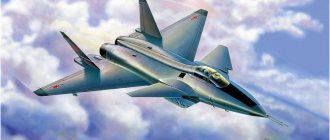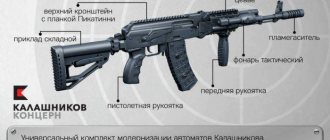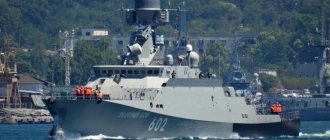The other day it became known that the moment of the aircraft's appearance is approaching - design should start in a few months.
RIA Novosti published an interview with the general director of RSK MiG Ilya Tarasenko. The head of the organization spoke about current work and plans for a number of modern and promising projects. Along with other topics, the PAK DP project was also discussed. I. Tarasenko said that research work is currently ongoing to shape the appearance of the future interceptor. All the basic requirements are included in the appearance of the car, and such work is planned to be completed by the end of this year. Approval of the finished technical design will allow us to move on to the next stages of the program.
The general director of RSK MiG revealed some features of the future PAK DP, but without much detail. The aircraft will be created using stealth technologies. It will be able to carry the required number of weapons of the required types and deliver them to an increased interception radius. At the same time, the MiG-41 will not just be an independent weapon. Work continues on a promising comprehensive global defense system capable of covering all borders.
The head of the Corporation did not give the exact timing of the appearance of the future PAK DP. However, he indicated that the MiG-41 will have to replace the MiG-31 when it ends its service.
A little about the MIG-31
The predecessor of the MIG-41, the “thirty-first”, in terms of technical characteristics and speed indicators, has gone so far from its foreign analogues that in the next 10–15 years ahead it will remain in the leading position, the only thing is that when the “forty-first” is released, it will shift to second line.
It is intended to detect and destroy ballistic and cruise missiles and aircraft located at various altitudes. Capable of successfully shooting down modern North American 5th generation fighters F-22 and F-35.
The MIG-31 quickly identifies an air target located within a radius of almost 300 km using a special antenna equipped with a phased array, a complete set of which is not found on any aircraft in the world.
Depending on the situation, the fighter's arsenal may contain various ammunition placed on both external and internal slings, which include long-range missiles designed in such a way that confirmation of the target location is not required to launch them.
If necessary, an interceptor fighter can serve as a mobile flying command post.
MiG-31 modernization: pros and cons
Afterburning mode of the MiG-31BM engines, used during takeoff and climb.
© Andrei Shmatko / wikimedia.org
Of course, Russia today needs to have the MiG-31 - a unique combat aviation complex to carry out the tasks of the aerospace defense and other troops. A grouping of modernized MiG-31s would make it possible to perform a number of space defense tasks: destroying enemy spacecraft and launching small satellites (up to 200 kilograms) into low (200-800 kilometers) Earth orbit. Moreover, according to domestic experts, the Russian Aerospace Forces currently has about 120 MiG-31s plus about 150 more aircraft at storage bases. According to their estimates, about 100 modernized MiG-31BMs are in service today.
Of course, modernization is a good and necessary thing. After its implementation, Russia will receive for many years a multifunctional, unrivaled long-range aircraft that will have no equal in the world. For many years to come, the MiG-31 will evoke a sense of pride in our great country, its Armed Forces, Soviet and Russian science and industry. However, there are certain disadvantages of doing it.
In particular, the State Armament Program for 2011-2020 did not provide for the resumption of production and acquisition of MiG-31 aircraft and its modifications. And modernization will require, according to various estimates, tens of billions of rubles, which today, during a period of decline in both the domestic and global economies, as well as the emergence of the coronavirus, will be quite difficult to find.
In addition, the technologies of a number of parts of the MiG-31 fighter were lost, in particular the nose cone, canopy, avionics, as well as the production of components. Although restoring lost technologies to a new technical level is quite possible even without a significant amount of testing of airframe structures.
To restore production, according to UAC forecast, it will take at least 15 billion rubles and five years. And this is a boost for the Russian economy. After all, the amount of funding for the state program “Development of the Aviation Industry” alone until 2025 is 1.2 trillion rubles
The irreversible loss of a large number of highly qualified personnel, which will be difficult to compensate, is also alarming.
It is necessary to increase the detection range of the MiG-31. In particular, on the MiG-25 with the Sapphire-25 radar it was greater than on the MiG-31, and, moreover, the “snake” maneuvers of the target did not affect the characteristics of the Sapphire-25 radar.
A modern radar (the Zhuk type, installed on the MiG-29SMT, MiG-35, Su-27KUB and others) will be able to provide a range of at least 400 kilometers versus the current 80. It is necessary to remove excess metal from the nose cone (air pressure receiver, antennas, wires ) and change its shape to ensure acceptable radio performance. A significant modernization of all aircraft electronic equipment and heat direction finder is required.
D-ZOF-6 engines stored in the warehouses of Perm Motor Plant OJSC belong to the second category and cannot be installed on new aircraft. Installation of engines of the second category will require changes in legislation. After refurbishment, the engines will be able to provide the required service life. This approach will not require large costs and time.
According to OAK, the resumption of engine production will require at least five billion rubles (included in the 15 billion announced by OAK). The plant retained the production of basic engine elements (production of blades and compressor and turbine stages).
It is no secret that currently the MiG-31’s missions are partially capable of being performed by the Su-35, MiG-29 and Su-57. True, even today they are inferior to it in supersonic cruising speed, climb rate and payload.
What will the MIG-41 be like?
Today it is known that specialists from the OKB are working on the design of a modern long-range interceptor fighter. Mikoyan and the Nizhny Novgorod Aviation Design Bureau. The project was started back in 2013 after a written order from the Commander-in-Chief of the Aerospace Forces, which after some time was duplicated by an order of the General Staff of the Russian Armed Forces.
Information slips into the press that the new fighter will reach speeds of up to 7,000 km/h.
To date, no aircraft of this type can accelerate to such limits.
For comparison, you can use the table, which shows the fastest fighters in the world.
| Fighter model | Country of Origin | The country in which it is in service | Maximum speed, km/h | Number of units produced |
| Raphael | France | France | 1 900 | 195 |
| Saab JAS 39 Gripen | Sweden | Czech Republic, Hungary, Thailand, South Africa, Sweden | 2 200 | 270 |
| MIG-29 | Russia | Russia | 2 415 | 1,500, production continues |
| MIG-23 | Russia | India, Syria, Libya | 2 445 | 3 630 |
| Typhoon | Germany | UK, Germany, Spain, Saudi Arabia, Italy, Austria | 2 450 | About 500 |
| SU-27 | Russia | Russia | 2 476,4 | 809 |
| Grumman F-14 Tomcat | USA | USA | 2 485 | 712 |
| McDonnell Douglas F-15 Eagle | USA | USA, Israel, Saudi Arabia, Japan | 2 650 | 1 500 |
| MIG-25 | Russia | Russia Ukraine | 2 700 | About 1,200 |
| MIG-31 | Russia | Russia | 3 000 | 519 |
As can be seen from the information presented, domestic developments are unparalleled leaders today. If the speed declared for the MIG-41 matches, it will become an absolute record holder in this area.
It should not be ruled out that all of the above modifications of Russian fighters were designed at the turn of the Soviet Union, that is, at the moment the projects are more than 30 years old.
Or maybe the MiG-41 will appear in the coming years?
The optimistic point of view on the Mig-41 project adheres to a slightly different concept. Since back in the 90s, the “701” project was developed as a replacement for the MiG-41, which was never completed, many experts see here a direct connection with the tanks of the “Armata” project, which were created according to a similar scheme. Remembering the history of the Armata project, you begin to believe that the MiG-41 will still be finalized in the coming years.
Some experts call one of the facts of the appearance of the MiG-41 the active phase of development of the RVV-BD missile, since it is being made specifically for the MiG-41.
Recent events on the world stage are forcing Russia to seriously think about the speedy development of the latest interceptor fighters. The Americans constantly and unequivocally hint that their newest hypersonic cruise missile, the Boeing X-51, which is almost ready for production launch, is capable of reaching speeds of up to 6,200 km/h. Only the MiG-41, which can also become unmanned, will be able to reach such speed and intercept an American missile.
Skeptics argue that Russian developments in the field of creating unmanned aerial vehicles are far from American ones, so the MiG-41 will be controlled by a pilot who simply cannot withstand the overloads that occur at such speeds. To this it can be objected that by 2028 Russian technologies can make great strides forward, and in the coming years the creation of “drones” will cease to be a problem for Russian designers.
Currently, the MiG-41 is only available in drawings, which are also not reliable. We can only hope that in a few years the first model of the Russian MiG-41 interceptor fighter will fly in the sky at the Victory Parade. Moreover, the general designer of the United Aircraft Corporation, Sergei Korotkov, recently officially stated that work on the creation of the MiG-41 is being carried out not only at RSK MiG.
Comments from officials
There has not yet been any information in official sources about whether this new aircraft has been created or not. It is quite possible that it is already in the test hangars of the Design Bureau named after. Mikoyan and is waiting in the wings. However, this remains classified information, and to date there is no information about technical characteristics, appearance and operational data.
It is only known that the MIG-41 fighter is a modern innovative development of a modern interceptor capable of replacing the MIG-31. Due to its secrecy, work on the machine was called “the most secret idea of the Russian defense industry.”
There are quite a lot of discussions on this topic on specialized forums, but they all end with unsubstantiated forecasts and assumptions.
According to Sergei Korotkov, President of the Russian United Aircraft Corporation, this year many separate projects were completed to assemble the fighter.
He once again emphasized that a modern interceptor fighter is being created to replace the outdated model that has been in use since 1975. In addition, it was noted that not only specialists from the Design Bureau are working on the creation of the aircraft. Mikoyan, but also a number of representatives of other enterprises related to the Russian defense industry.
Development is being carried out according to a pre-order received from the Russian Defense Ministry, since in fact the task is to replace the obsolete MIG-31 with a new modern modification. Korotkov did not provide any other information.
Colonel General of the Russian Air Force Viktor Bondarev expresses himself as follows: “Work on the project is being carried out quite actively, at the moment the main actions are carried out in the person of scientific researchers who submit design documentation for the start of experimental design work.”
Also, the commander-in-chief emphasized that the modern MIG-41 interceptor fighter will be put into service in 2025.
Several years ago, a test pilot commented on the situation by saying that a new fighter should have appeared at the turn of the century.
Replacing the MiG-31 with the latest aircraft
Despite the fact that the MiG-31 still has no equal in its class, it is already a fairly outdated fighter. Even next to such aircraft as the Su-27 or MiG-29, which have long become “veterans”, the MiG-31 looks downright outdated.
From the conversations that are taking place around the creation of a replacement for the MiG-31, the following information can be obtained:
- The new aircraft will have an enormous maximum speed, which will look impressive even against the background of the MiG-31;
- The appearance of the new vehicle will resemble the MiG-31;
- The MiG-41 interceptor fighter will be created on the basis of the MiG-31BM, which is the most modern modification of the MiG-31.
Since military designers, according to a long tradition, keep silent about the details that relate to the development of a new model, one can only guess what the appearance of the MiG-41 will actually be. One thing is clear, the MiG-41 may not even match its predecessor in appearance, since the project can be changed at any time. It is possible that the military will present its first developments by 2020, although this is only possible if work on creating a new interceptor fighter proceeds at a very fast pace.
If we compare the future MiG-41 with the MiG-31, the new aircraft will be distinguished by the presence of a large number of electronics, and its appearance will be less noticeable. Nothing definite can be said about the armament of the MiG-41 now, since although the latest RVV-BD missile is currently being developed, which should receive a dual-mode rocket-type engine, it is unknown what kind of weapon will appear by 2028. It is possible that these weapons will be the latest combat laser systems, which are currently being developed in US laboratories. Although Russia says nothing about the development of combat laser cannons, it is possible that this project also exists.
Scientists also have high hopes for the MiG-41, as it will be able to launch small satellites into orbit as usual.
Predecessors: a perspective on history
The experimental flight design bureau of Artyom Mikoyan was created on December 8, 1939, and it is from this moment that the history of the predecessors of the new MIG-41 fighter can begin.
The first aircraft of the OKB was created in 1940, it was the MiG-1, developed on the basis of Polikarpov’s developments. After being put into production and military testing, it was refined and improved, and the resulting fighter became known as the MiG-3.
Both aircraft took part in the Great Patriotic War, but were discontinued in 1942 due to a shortage of AM-35 aircraft engines, as the production line was transferred to the production of the related AM-38 engines, which were needed for the Il-2 attack aircraft.
The MiG Design Bureau used the time remaining until the end of the war to develop new aircraft models that did not go into mass production, but gave the bureau's aircraft designers experience and skills in working with aerodynamics and engines.
The history of the creation and development of jet aircraft by the Mikoyan Design Bureau begins almost immediately after the war. Mikoyan and Gurevich were the first to propose the MiG-9 jet fighter, a transitional model with a jet engine and a straight wing.
Next was the famous MiG-15. Then there were milestones in aircraft construction, such as the high-speed record-breaking MiG-25 and ordinary models that served honorably in the Air Force of the Motherland, for example, the MiG-17 interceptors.
Since that time, the following modifications have been recognized as the best:
- The MiG-15 , the first Soviet fighter with a swept wing, had one 37 mm and 2 23 mm cannons on board. It reached speeds of more than 1,000 km/h. Serial production was carried out at 9 factories, in total more than 18,000 fighters were built;
- MIG-19 is the first aircraft in the whole world that is capable of reaching supersonic speed. Produced since 1955 in Gorky and Novosibirsk. A total of 1,890 units were produced, which could differ in different types of installed weapons. By the way, the “nineteenth” was the first to be equipped with air-to-air missiles;
- MIG-21 - a new interceptor of that time was created almost at the same time as the MIG-19, but received greater recognition. It became the first domestic aircraft with delta wings and the most common supersonic fighter in the world;
- MIG-23/27 - took part in all military operations of the 80s. Aircraft with variable wing sweep, which provided the most optimal flight conditions for each specific combat conditions. This gave the fighter a tremendous advantage over its second and third generation counterparts. After the release of the American F-16, which belonged to the next, 4th generation, its superiority was lost;
- The MIG-25 has more than once confirmed what was said about it, that the maximum speed for it is specified only in the technical specifications. He is a numerous world record holder according to these data;
- MIG-29 was developed in the period 1972-1982. At that time, the main goal was to achieve characteristics related to increasing the reliability of the machine and meeting the wishes of foreign customers.
The next model that replaced the “twenty-fifth” is the MIG-31 interceptor, which is being successfully used today and is awaiting replacement in the form of the developed MIG-41, which outruns missiles.
Although the newest fighter has not yet been created, most potential opponents are already in excitement, since even the outdated model of the “thirty-first” is in many ways superior to all foreign analogues.
And according to the promises of those responsible for the design and development of the MIG-41 aircraft, it should become even more advanced.
MiG-41 Interceptor: “Fox Hound” of the 21st Century – Naked Science
The PAK DP (advanced long-range interception aircraft complex) program is attracting more and more attention. Let's figure out what it is and whether Russia will have a new combat aircraft.
Park update
Russia has almost received the first serial fifth-generation fighter, completed under the PAK FA program, and in the foreseeable future there may be a presentation of a promising strategic bomber known as the PAK DA - or “Messenger”. The first will replace fighters built on the basis of the old Su-27, such as the Su-27SM and Su-30, as well as the few surviving MiG-29: the prospects for its successor, the MiG-35, are still vague. PAK DA, accordingly, is replacing all strategic and long-range bombers.
In this regard, they are increasingly talking about the need for a replacement for the MiG-31, especially since these aircraft are unique and are considered the fastest winged combat vehicles in service. The maximum speed of the 31st is 3000 kilometers per hour, cruising speed is 2500. This is significantly higher than any modern fighter, including the new, fifth generation.
The MiG-31 fighter is based on the Soviet MiG-25, which took off in 1964 and largely predetermined the development of aviation. Fearing the speed of the MiG-25, the Americans finally abandoned the development of the super-fast Valkyrie bomber: in the new realities, its capabilities no longer guaranteed invulnerability.
It would have been a sin not to take advantage of the unique capabilities of the Soviet interceptor in the 90s, and the country’s leadership understood this. This is how the MiG-31BM appeared - a modernized version. The aircraft received a new weapons control system and radar, allowing it to detect targets at a range of up to 320 kilometers. Let us note in fairness that this applies to targets that do not have radar stealth - that is, not stealth.
| Mig-31. |
| Source: Photo of the Russian Ministry of Defense |
Another important advantage of the MiG-31BM is the ability to use the latest long-range air-to-air missiles R-37. This is a development of the old Soviet R-33 missile, which the MiG-31 can use. However, if the old missile has a target overload limitation of 4 G (which means it cannot effectively hit maneuverable targets), then for the R-37 this figure should be 8 G. We can say that the MiG-31 aircraft has transformed from a highly specialized interceptor capable of effectively fight only cruise missiles and strategic bombers, into a multifunctional complex that can even withstand the fighters of a potential enemy.
One of the most interesting projects in the field of aviation weapons was the KS-172 ultra-long-range air-to-air missile being developed in Russia, which was worked on back in the 90s. Its launch range was supposed to be up to 400 kilometers. But the lack of any information in recent years allows us to make an assumption that the project has been frozen / ©Wikipedia
| One of the most interesting projects in the field of aviation weapons was the KS-172 ultra-long-range air-to-air missile being developed in Russia, which was worked on back in the 90s. Its launch range was supposed to be up to 400 kilometers. But the lack of any information in recent years allows us to assume that the project has been frozen. |
| Source: ©Wikipedia |
But it's not that simple. The problem is a change in the generation of military equipment, or, more precisely, in the already mentioned stealth, around which a modern aviation complex, such as the F-22, F-35 or Su-57, is built. The MiG-31 was never stealth, it will never achieve the performance of aircraft that were originally created with an emphasis on “invisibility.” That is, to put it simply, it will not become a combat vehicle of the 21st century. We need another plane.
Missed Opportunities
MiG understood this very well, however, the company missed its chance, unlike Sukhoi, which has been around since the early 2000s. Let us recall that on February 29, 2000, the prototype of the fifth generation MiG 1.44 fighter took to the skies for the first time, which was created as a counterweight to the F-22 fighter and which, as reported, was superior to the American “hawk” in a number of characteristics. Thus, the maximum speed of the MiG 1.44 aircraft should have exceeded even the speed of the MiG-31 and reached 3200 kilometers per hour. However, then scandals, revelations followed, and the general plight of the industry took its toll. In 2002, a government decree was issued on the creation of the Su-57, which finally put an end to the history of the MiG 1.44. Disputes about the correctness of this decision are still raging. But, if you take away the emotions, you need to recognize one fact.
| Fifth generation fighter MiG-1.44 at MAKS-2015. |
| Source: CC BY 2.0 / Artem Katranzhi / Mikoyan Project 1.44 on display at MAKS 2015 |
The advantage of the Su-57 concept over the MiG 1.44 was that the aircraft was initially built as a stealth aircraft, while the Migov prototype was devoid of even a hint of stealth - in the modern American understanding of the term. Perhaps this was the reason for the abandonment of the project.
Also, the successor to the MiG-31 could be the heavy interceptor “Project 701” (Project 70.1?), which was allegedly developed back in the early 90s. The flight range of the giant 62-ton aircraft was supposed to be seven thousand kilometers, and the maximum speed was 2,500 kilometers per hour. However, the reliability of information about the interceptor raises many questions. Most likely, such a car would never have appeared, even if the country had the money for it in those years.
MiG of the future: first data
The future of Russian interceptors, if there is one at all, lies with the PAK DP (Advanced Airborne Long-Range Intercept) program, also known as the MiG-41. What kind of program is this and how active is it now? Let’s try to figure it out.
The problem is that the few statements from pilots and aircraft manufacturers do not so much answer the questions asked, but rather create even greater confusion. So, in 2014, test pilot Anatoly Kvochur announced the car. “Such modernization should have taken place 20 years ago. However, this did not happen then, so now the requirements are increasing. They include (increasing – author’s note) the speed of the interceptor to Mach 4-4.3,” he said. The now former Commander-in-Chief of the Aerospace Forces, Viktor Bondarev, made his statement on this matter in 2022. “The range will be in the range from 700 to 1,500 kilometers. It is planned to arm it with the R-37 air-to-air missile, as well as fundamentally new missiles, the military man said. “It is supposed to be the fastest fighter in the world.”
| This is what the interceptor of the future might look like. |
| Source: ©Wikipedia |
It is not clear why the plane needs such speed: achieving such indicators in practice will require unimaginable forces and technologies, which, apparently, no other country has. In addition, by the time the aircraft is put into service, the far from new R-37 missile (in a broad sense, just a modification of the Soviet R-33) may be completely outdated.
However, now, on the basis of the already mentioned R-37, a new RVV-BD missile is being developed, which, as sources note, has a dual-mode solid-fuel rocket engine and an improved homing head GSN 9B-1103M-350 “Shaiba”. Visually, the new missile differs from the R-37 by having a head compartment shortened by about 15 centimeters with a radio-transparent fairing of a modified shape. It is assumed that the missile will be able to hit targets at a range of more than 300 kilometers. However, it is necessary to take into account a number of circumstances, some of which have already been considered.
| R-37 (RVV-BD). |
| Source: ©dfnc.ru |
Firstly, when a missile is launched at a maneuvering target (say, a fighter), it will be forced to maneuver itself, losing energy. Secondly, aiming a missile at a stealth target is associated with a number of difficulties, so the effective launch range against stealth aircraft can be less than 100 kilometers, not to mention 300. In addition, long- and ultra-long-range missiles are traditionally high in price and even exceed the cost medium-range missiles, such as the AIM-120 or R-77.
Most likely, the arsenal of the future interceptor could include both long/ultra-long-range missiles and medium- and short-range missiles, as can be seen in the example of early upgrades of the MiG-31. It was assumed, for example, that the MiG-31M would be able to carry up to six R-33/R-37 missiles under the fuselage and four medium-range RVV-AE missiles on underwing units. Thus, R-33 missiles could be used against low-maneuverable targets such as “strategic bomber” or “cruise missile”, while medium-range missiles would be used to combat fighters.
Obviously, if there is real interest in the PAK DP on the part of the Ministry of Defense, they will try to make it as multifunctional as possible, but with an emphasis on interception. Let us recall that the functions of a multirole fighter will be performed by the Su-57, which is more suitable for these tasks than an interceptor.
Invisible fighter
Finally, we come to the most important thing: what exactly will distinguish the conventional MiG-41 from the 31st and its numerous upgrades.
Firstly, speed. If you believe the words of Anatoly Kvochur about a speed of Mach four, it must be said that achieving such indicators within the framework of the old platform is impossible. Consequently, the aircraft will most likely have to be created from scratch - with an emphasis on higher performance characteristics. Secondly (this is perhaps even more important), there is reason to believe that they want to see the PAK DP as a stealth vehicle, like the Su-57 or F-22, as we have already said.
“The promising aircraft (PAK DP) will use new types of aircraft weapons, it will be created using new stealth technologies, will be able to transport the required number of weapons, and will operate at a very large interception radius,” said the general director of the MiG aircraft manufacturing corporation in 2022 » Ilya Tarasenko.
The head of the company added that these requirements are included in the design of the aircraft, and scientific and technical work on it should be completed by the end of 2022. Let us remember that in 2018, Tarasenko announced the reality of the development. “This is not a mythical project, the project for MiG is a long-standing one, now under the auspices of the UAC we are intensively carrying out this work and will soon present it to the public,” he noted.
In 2022, the scientific director of the FSUE GosNIIAS, Academician of the Russian Academy of Sciences Evgeny Fedosov, said that the military was also considering the PAK DA strategic bomber (advanced long-range aviation complex) as a long-range interceptor.
However, one version of the transformation of the MiG-31 into a PAK DP still cannot be ruled out. Let us recall the American project Boeing F-15SE Silent Eagle, aimed at partially converting an old aircraft into a stealth aircraft. The F-15SE fighter was equipped, for example, with a V-shaped vertical tail, and some of the weapons (also for the sake of maintaining radar stealth) were removed into the internal compartments. “The low-profile aircraft for the poor,” as it was nicknamed, did not meet with much interest on the market, since there are more advanced aircraft and the device can no longer fully satisfy modern requirements.
| F-15SE at presentation, 2009. |
| Source: ©Wikipedia |
As already noted, everything speaks in favor of the MiG engineers developing a new machine, and not a modernized MiG-31. Another question is how interesting it is to the Ministry of Defense. In October 2022, it became known that the Russian military department received materials on the project of a promising long-range interception aircraft complex, which is being created to replace the MiG-31. This was announced then by the General Designer, Vice President for Innovation of the United Aircraft Corporation Sergei Korotkov. But so far there are no official statements that would seriously allow us to talk about interest in the car on the part of the Russian Defense Ministry.
Can a program exist outside of the desire of the VKS to get a new interceptor? It’s a difficult question, and the most correct answer to it is probably not.
The market for combat aircraft is not as broad as the market for civil aviation. This can be seen even in the example of relatively popular multi-purpose machines. There is nothing to say about highly specialized interceptors, as well as front-line bombers like the Su-34. Most likely, it will not be possible to find international customers for the new aircraft, even if the aircraft is successful. A heavy interceptor is of interest only to countries that have very long borders and, therefore, the need to protect these same borders. There are not many such states, and some, for example China, have their own aircraft industry.
MiG-41: is it necessary?
The implementation of the PAK DP program will cost, without exaggeration, fantastic amounts of money, which is clearly seen in the example of fifth-generation fighters. The F-22 development program cost American taxpayers more than $60 billion, while the F-35 project cost over $50 billion. It can be assumed that sixth generation fighters will require even greater investment.
How much will a promising interceptor with the makings of a sixth generation cost Moscow? No one can answer this question now, but there is no doubt that the amount will be astronomical, especially by Russian standards.
Coupled with technical risks, this raises uncomfortable questions and casts doubt on the feasibility of something like this. They don’t really believe in PAK DP in the West either. Thus, aviation specialist Justin Bronk from the Royal Institute of Defense Studies previously said that he sees no prospects for the MiG-41, since “Russia does not always follow through with serial deliveries of new military equipment.” However, this thesis is only partly true. New equipment always requires a long period of bringing it to a combat-ready state, that is, no one (at least now) has refused either the Su-57 or the T-14 tank. Moreover, this year information appeared about the conclusion of a contract for the supply of seventy-six Su-57s to the troops.
More important are the conceptual issues that Business Insider journalists previously drew attention to. “The best method of interception is surface-to-air missiles.” And the Russians are talking about the MiG-41 to promote another aircraft – the MiG-29SM,” they note. Indeed, the S-400 anti-aircraft missile system, provided that the new 40N6E missile is used, will theoretically be able to hit targets at a range of almost 400 kilometers. The combat radius of the MiG-31 is 700 kilometers, and the range of its R-37 missiles, as we have already said, can reach 300 kilometers. Thus, the conclusions of Business Insider experts are not entirely correct: neither the S-400 nor the S-500 can become a full-fledged replacement for an interceptor aircraft.
However, the functions of the MiG-31/MiG-31BM will be partially taken over by the Su-57 fighters, which, as previously stated, should learn to use RVV-BD missiles. If we take into account the planned installation of the second stage engine, Type 30, on the Su-57, the cruising speed of the aircraft, in theory, will not be inferior to that of the F-22 Raptor. That is, it can be above 1500 kilometers per hour.
So, PAK DP may simply not be needed due to the availability of other modern machines. However, not everything is simple here either. The fact is that a number of experts, both in Russia and in the West, are “wooing” the MiG-41 into a sixth-generation fighter. Let us remind you that active work in this area is currently being carried out in Europe and the USA: just remember the American F/A-XX and the European New Generation Fighter. The logic is clear: the F-35 and F-22 will not last forever, sooner or later they will have to be replaced.
So far, the requirements for the sixth generation have not been fully formed. But experts believe that we may be talking about an aircraft built using stealth technology and capable of reaching hypersonic speed. This is where MiG’s developments in PAK DP can come in handy. To put it simply, the MiG-41 may in fact not be a replacement for the MiG-31, but a successor to the Su-57. That is, not an interceptor, but a multifunctional fighter that combines high speed, good maneuverability and the ability to hit ground targets. In a word, we'll wait and see.
Ilya Vedmedenko
The Paper: The US won't be able to deal with this Russian missile anytime soon
Main characteristics of the MiG-41:
This type of interceptor belongs to the fourth generation aircraft (Russian fifth generation aircraft). It uses new stealth technology and is expected to have a speed of Mach 4-4.3 and a combat range of 1,400-1,500 kilometers, which is significantly greater than the MiG-31's range of 700-720 kilometers.
The aircraft will be equipped with the latest high-performance targeted search and detection equipment, and its radar reflective capability will be further upgraded and efficient. In the future, it will be able to work with Russia's global defense system, be able to exchange data in real time, thereby ensuring the receipt of information from external targets and other elements of the system.
This model will reportedly use a ramjet engine (ramjet engine) or even a pulse detonation engine.











